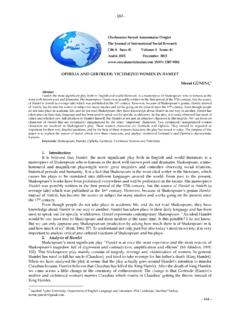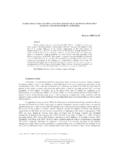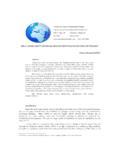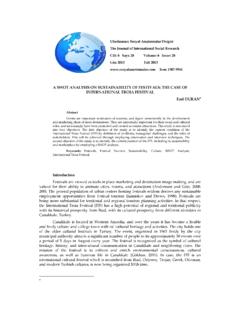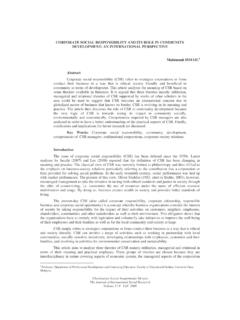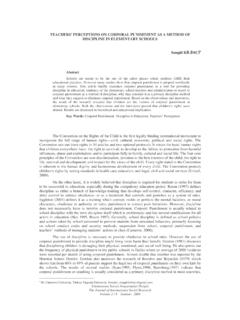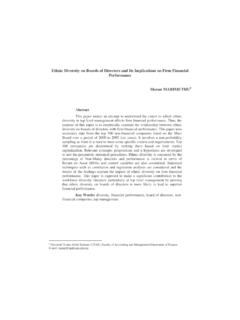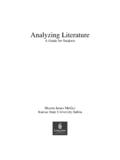Transcription of Discourse Markers in English Writing Li FENG
1 Uluslararas Sosyal Ara t rmalar Dergisi The Journal of International Social Research Volume 3 / 11 Spring 2010 Discourse Markers in English Writing Li FENG Abstract Many devices, such as reference, substitution, ellipsis, and Discourse marker , contribute to a Discourse s cohesion and coherence. This paper focuses on Discourse Markers role in Chinese Students English Writing , analyzing the misuse and inappropriateness of Discourse Markers occurring to their Writing , and concludes with the suggestion that Discourse Markers should be paid some attention when we teach Writing . Key Words: Discourse Markers , cohesion, coherence, inappropriateness I. Introduction Discourse Markers --- expressions like well, but, oh and y know --- are one set of linguistic items that function in discourses of various styles or registers.
2 Fraser (1998: 301) calls Discourse marker analysis a growth market in linguistics. Since the late 1980 s Discourse Markers have been studies in a variety of languages and examined in a variety of genres and interactive contexts, though many scholars do not agree on how to define them, even what to call them. Redeker (1991: 1168) calls them Discourse operators and defines them as a word or phrase, for instance, a conjunction, adverbial, comment clause, interjection that is uttered with the primary function of bringing to listener s attention a particular kind of the upcoming utterance with the immediate Discourse context. Schiffrin provides an operational definition . He define[s] Discourse Markers at a more theoretical level as members of a functional class of verbal and nonverbal devices which provide contextual coordinates for ongoing talk (1987: 41).
3 Discourse Markers are sequentially dependent elements which bracket unit of talk (Schiffrin, 1987: 31). Fraser (1998:302) defines a Discourse marker is a lexical expression which signals the relation of either contrast (John is fat but Marry is thin), implication (John is here, so we can start the party), or elaboration (John went home. Furthermore, he took his toys) between the interpretation of S2 [S = segment] and the interpretation of S1. Discourse Markers have variant degrees of semantic meaning; they are utterance-initial; and they can signal a Discourse relationship or signal a writer s or a speaker s attitude. When we are planning to write a well-organized text, cohesion and coherence must be taken into consideration.
4 The organization of sentences of a text or a written Discourse is not like putting up bricks one upon one. There exist some relations between those sentences. Halliday and Hasan have defined a text as not just a string of sentences. It is not simply a long grammatical unit, something of the same kind as a sentence, but differing from it in size --- a sort of supersentence, a semantic unit (1976: 291). Discourse relations are believed to transcend grammatical structure. In Cohesion in English (1976) Halliday and Hasan identify five main cohesive devices in English Discourse : reference, substitution, ellipsis, lexical cohesion and conjunction. Conjunction, or connective element, which is what Halliday calls Discourse Markers , involves the use of formal Markers ( Discourse Markers ) to relate sentences, clauses and paragraphs to each other.
5 Unlike reference, substitution, and ellipsis, the use of conjunction does not instruct the reader to supply missing information either by looking for it elsewhere in the text or Jinling Institute of Technology, Nanjing China Uluslararas Sosyal Ara t rmalar Dergisi The Journal of International Social Research Volume 3 / 11 Spring 2010 300by filling structural slots. Instead, conjunction signals the way the writer wants the reader to relate what is about to be said to what has been said before. Some Discourse Markers are summarized as follows: 1. Additive: and, or also, in addition, furthermore, besides, similarly, likewise, by contrast, for instance; 2. Adversative: but, yet, however, instead, on the other hand, nevertheless at any rate, as a matter of fact; 3.
6 Causal: so, consequently, it follows, for, because, under the circumstances, for this reason; 4. Continuatives: now, of course, well, anyway, surely, after all; etc. Apparently, conjunction is related to the entire environment of a text. The conjunctive elements ( Discourse Markers ) presuppose the presence of other components in the Discourse (Halliday, 1976: 226). Not only giving cohesion to a text, they also cohere two sentences together. II. Hypothesis Judging from the work reviewed thus far, Discourse Markers play an important role in a text s cohesion and coherence. We can assume that Discourse Markers have some relationship with a Discourse s cohesion, texture and coherence. Then we can put forward a hypothesis: in order to make their English Writing more cohesive and more coherent, besides reference, substitution and ellipsis students are also very likely to use Discourse Markers in their essays.
7 If this were true, teacher should be clear about how their students use Discourse Markers and whither they use Discourse Markers correctly and appropriately. Knowing that, teachers can take positive and effective steps when they teach English Writing . Therefore, an experiment is needed to verify the hypothesis. III. Description of the Experiment 1. Participants Thirty-eight students who major in tourism management & English participated in this experiment. They are sophomores and possess a certain English proficiency to express their ideas. 2. Method The subjects were required to write an article on the topic of How do You Think of English without limit of words. The Writing was assigned as a classroom task, and the subjects did not know the purpose of this experiment.
8 Thus we could ensure the subjects would use Discourse Markers as usual. After collected, a small corpus of 38 articles has been established. Then the 38 articles were examined whether Discourse Markers had been used in them and how many Discourse Markers had been used. 3. Results The following tables reveal the results of the experiment. S stands for Subject. F refers to Frequency of Discourse Markers which are used in writings. T refers to the total words of every subject s Writing . The results will be demonstrated in the following appendix in much more detailed and specific. Uluslararas Sosyal Ara t rmalar Dergisi The Journal of International Social Research Volume 3 / 11 Spring 2010 301 Table 1: S 01 02 03 04 05 06 07 08 09 10 F 9 4 3 12 17 19 9 10 8 11 T 284 144 144 280 323 430 119 239 221 224 S 11 12 13 14 15 16 17 18 19 20 F 9 15 2 8 7 12 11 7 5 11 T 270 276 225 396 189 230 237 232 204 268 S 21 22 23 24 25 26 27 28 29 30 F 22 7 18 5 8 12 5 8 11 6 T 697 229 372 206 134 231 231 199 226 229 S 31 32 33 34 35 36 37 38 F 8 6 11 13 8 19 8 8 T 241 133 206 366 209 266 203 212 IV.
9 Analysis of the result The rate between the number of Discourse Markers and the total number of words reveals that student s English Writing do abound with Discourse Markers . When teachers teach English Writing , some of them concentrate on spelling mistakes, some on grammatical mistakes, some on Writing styles, some on Writing structure. In fact, Discourse Markers have been neglected in Writing teaching, for the research on this linguistic part has been newly established. English teachers seldom take Discourse Markers seriously when they teach Writing . Therefore, most students use Discourse Markers in their Writing just following their intuition toward cohesion and coherence. This may lead to the following phenomena: 1.
10 Some students seldom use Discourse Markers to avoid unpredicted mistakes. S13 is one of the examples. In their articles they employ Discourse Markers as few as possible. But this makes their Writing a bit unnatural. Subject 13: English is a very important language in the world. A large number of people speak it though China population is the largest one. [However,] You must accept the fact. With China s entry into WTO, our country has entered a period of important strategic opportunities. [But sometimes] We never know how to greet foreigners when we meet them. Quite a number of students think that English is a boring subject. But we still learn English and make it well. How to improve our English ?
